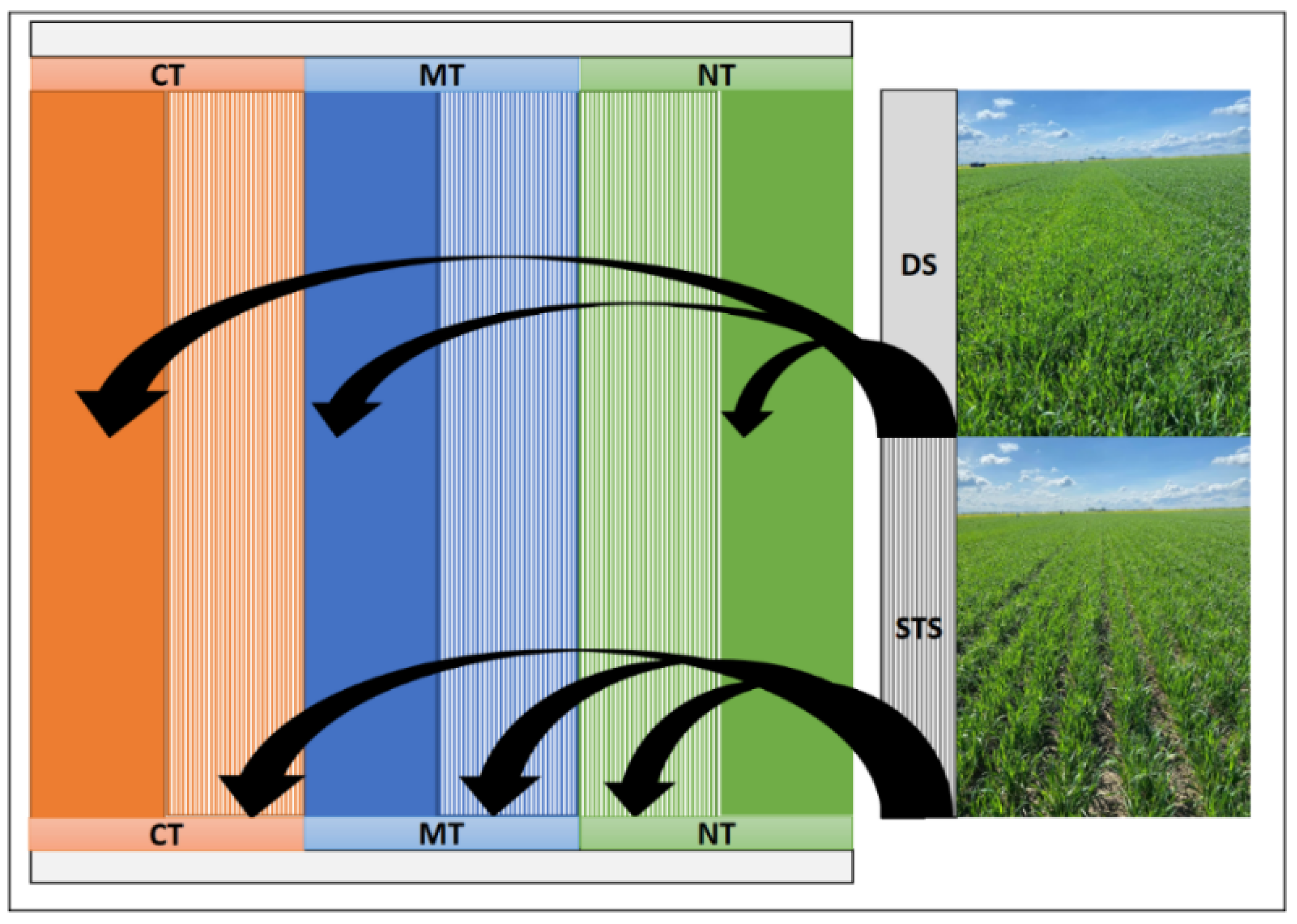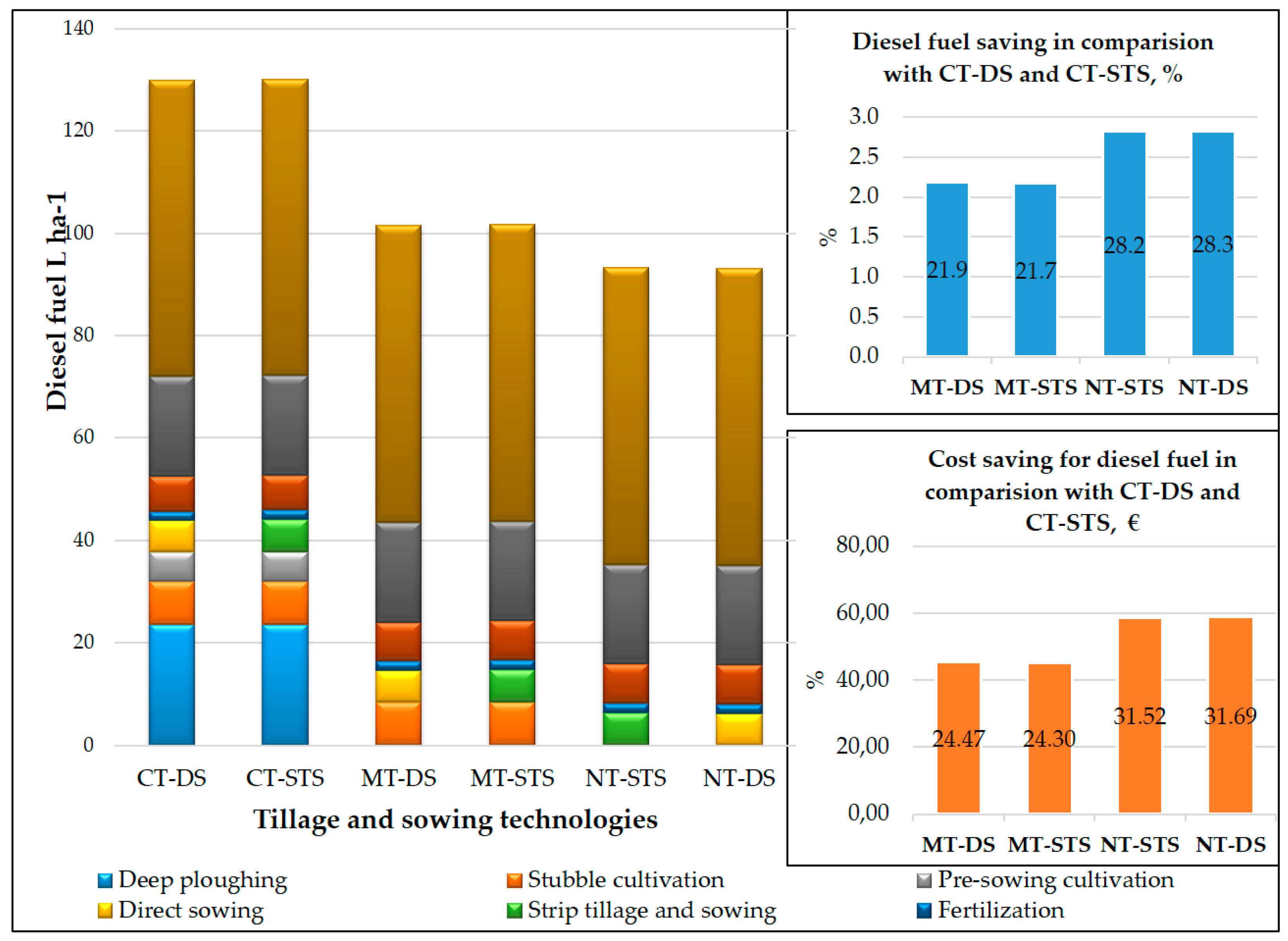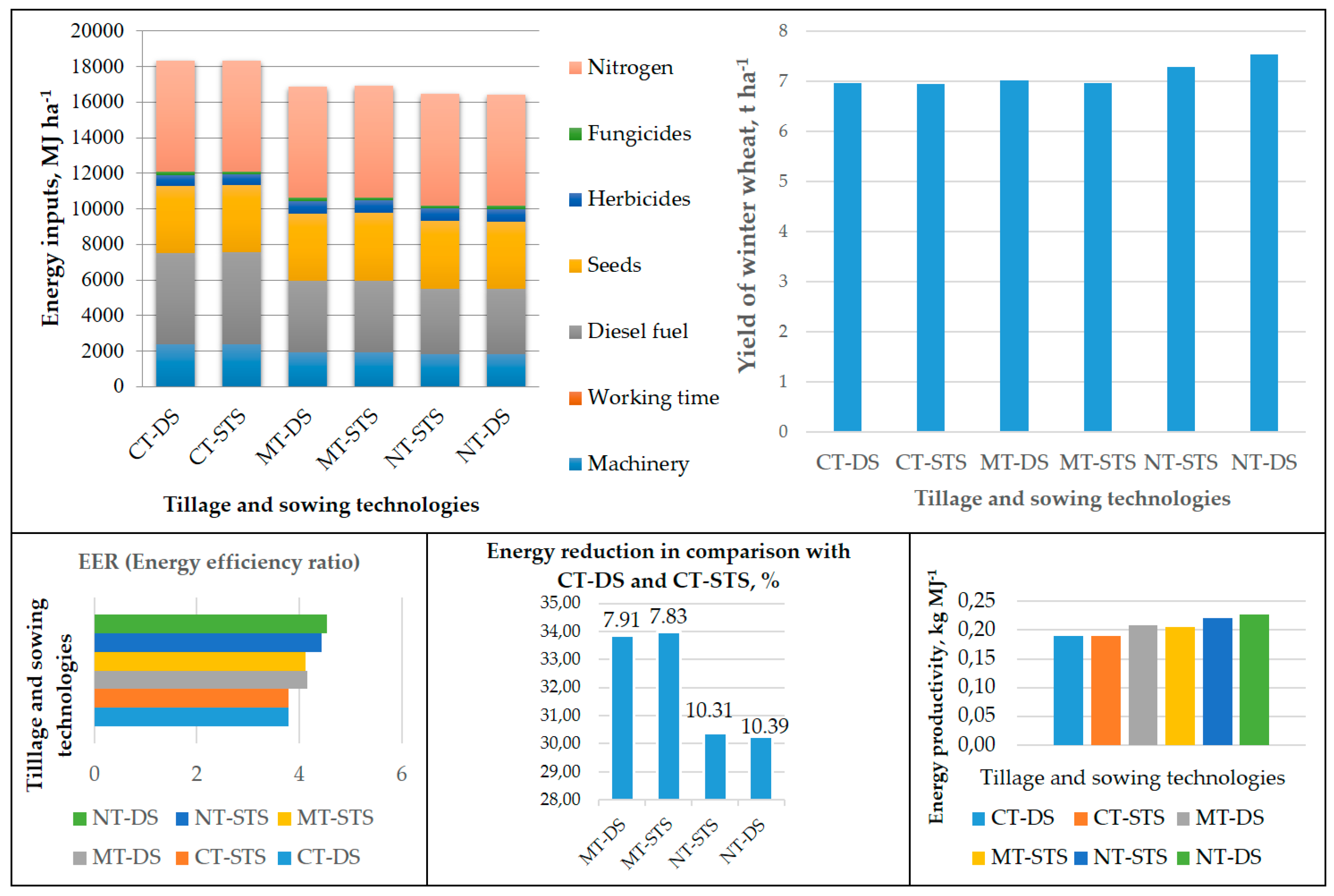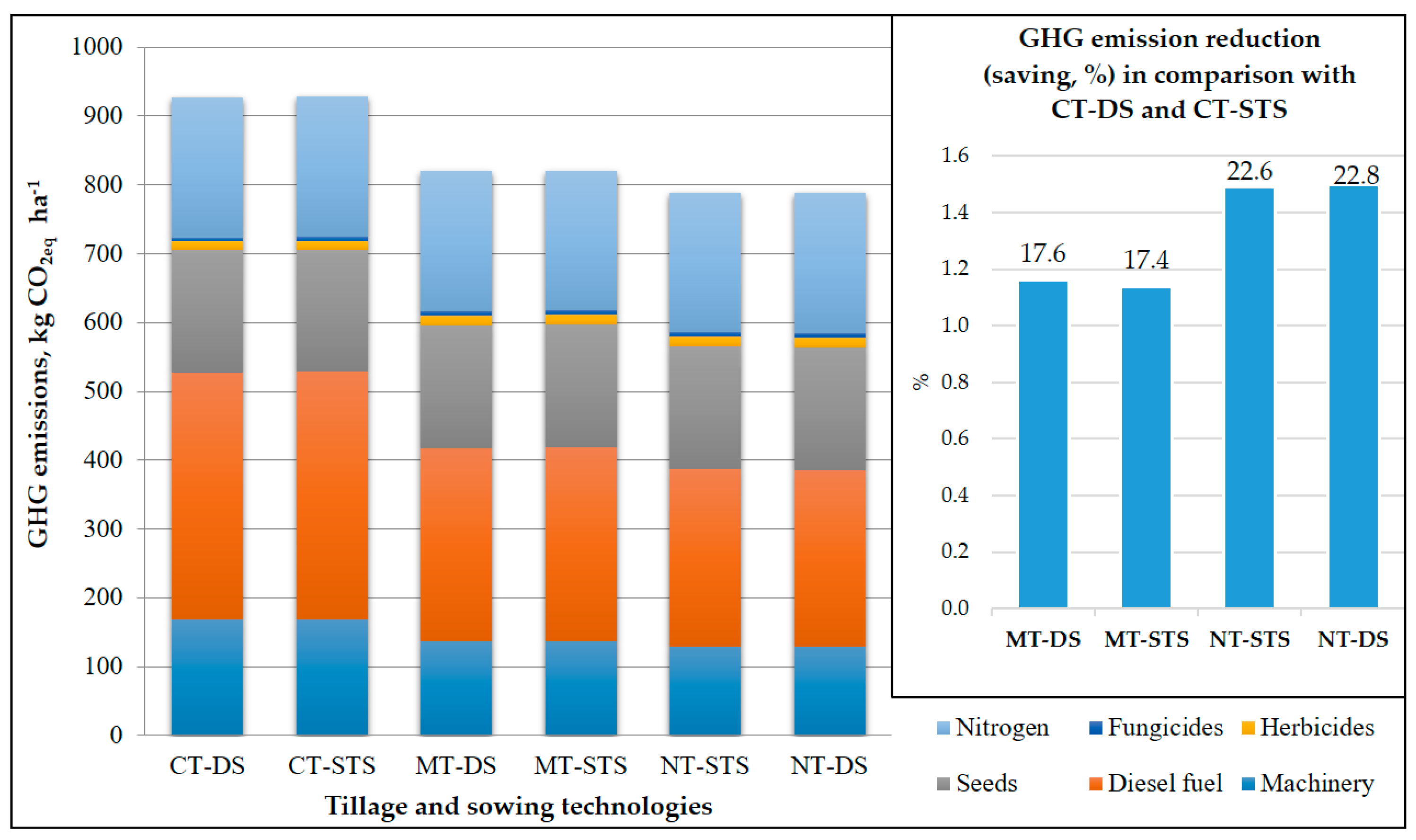Effect of Tillage and Sowing Technologies Nexus on Winter Wheat Production in Terms of Yield, Energy, and Environment Impact
Abstract
1. Introduction
2. Materials and Methods
2.1. Study Site and Experimental Design
2.2. Energy Assessment Indicators
2.3. Environmental Impact Assessment
2.4. Statistical Analysis
3. Results
3.1. Fuel Consumption of Tillage and Sowing Technologies
3.2. Working Time of Tillage and Sowing Technologies
3.3. Energy Consumption Analysis in Winter Wheat Production
3.4. CO2eq Emissions Analysis and Its Cost in Winter Wheat Production
4. Discussion
4.1. Fuel Consumption for Different Tillage and Sowing Technologies
4.2. Time Consumption Analysis
4.3. Energy and Grain Yield Parameters
4.4. CO2eq Emissions Analysis and Its Cost in Winter Wheat Production
5. Conclusions
Author Contributions
Funding
Institutional Review Board Statement
Informed Consent Statement
Data Availability Statement
Acknowledgments
Conflicts of Interest
References
- Rebolledo-Leiva, R.; Angulo-Meza, L.; Iriarte, A.; González-Araya, M.C. Joint carbon footprint assessment and data envelopment analysis for the reduction of greenhouse gas emissions in agriculture production. Sci. Total Environ. 2017, 593, 36–46. [Google Scholar] [CrossRef] [PubMed]
- Martin, N.P.; Russelle, M.P.; Powell, J.M.; Sniffen, C.J.; Smith, S.I.; Tricarico, J.M.; Grant, R.J. Invited review: Sustainable forage and grain crop production for the US dairy industry. J. Dairy Sci. 2017, 100, 9479–9494. [Google Scholar] [CrossRef] [PubMed]
- Akhtar, K.; Wang, W.; Ren, G.; Khan, A.; Nie, E.; Khan, A.; Feng, Y.; Yang, G.; Wang, H. Straw mulching with inorganic nitrogen fertilizer reduces soil CO2 and N2O emissions and improves wheat yield. Sci. Total Environ. 2020, 741, 140488. [Google Scholar] [CrossRef] [PubMed]
- Change, I.C. Mitigation of Climate Change. Contribution of Working Group III to the Fifth Assessment Report of the Intergovernmental Panel on Climate Change; Cambridge University Press: Cambridge, UK, 2014; p. 1454. [Google Scholar]
- Stocker, T.F.; Qin, D.; Plattner, G.K.; Tignor, M.; Allen, S.K.; Boschung, J.; Nauels, A.; Xia, Y.; Bex, V.; Midgley, P.M. Climate Change 2013: The Physical Science Basis: Working Group I Contribution to the Fifth Assessment Report of the Intergovernmental Panel on Climate Change; Cambridge University Press: Cambridge, UK, 2013. [Google Scholar]
- Fedoroff, N.V. Food in a future of 10 billion. Agric. Food Secur. 2015, 4, 11. [Google Scholar] [CrossRef]
- Uphoff, N.; Ball, A.; Fernandes, E.; Herren, H.; Husson, O.; Palm, C.; Pretty, J.; Sanginga, N.; Thies, J. Understanding the Functioning and Management of Soil Systems; CRC Press: Boca Raton, FL, USA, 2006. [Google Scholar]
- Shah, F.; Wu, W. Soil and crop management strategies to ensure higher crop productivity within sustainable environments. Sustainability 2019, 11, 1485. [Google Scholar] [CrossRef]
- Godfray, H.C.J.; Beddington, J.R.; Crute, I.R.; Haddad, L.; Lawrence, D.; Muir, J.F.; Pretty, J.; Robinson, S.; Thomas, S.M.; Toulmin, C. Food security: The challenge of feeding 9 billion people. Science 2010, 327, 812–818. [Google Scholar] [CrossRef]
- Wu, W.; Ma, B.L.; Whalen, J.K. Enhancing rapeseed tolerance to heat and drought stresses in a changing climate: Perspectives for stress adaptation from root system architecture. Adv. Agron. 2018, 151, 87–157. [Google Scholar] [CrossRef]
- FAO. FAOSTAT Statistics Database. 2017. Available online: http://www.fao.org/faostat/ (accessed on 10 September 2022).
- Agricultural Information and Rural Business Center. Available online: https://www.vic.lt/ (accessed on 26 September 2021).
- Lal, R.; Eckert, D.J.; Fausey, N.R.; Edwards, W.M. Conservation tillage in sustainable agriculture. In Sustainable Agricultural Systems; CRC Press: Boca Raton, FL, USA, 2020; pp. 203–225. [Google Scholar]
- Jarecki, M.K.; Lal, R. Compost and mulch effects on gaseous flux from an alfisol in Ohio. Soil Sci. 2006, 171, 249–260. [Google Scholar] [CrossRef]
- Birkás, M. Environmentally-Sound Adaptable Tillage–Solutions from Hungary; Akademiai Kiado: Budapest, Hungary, 2008; pp. 191–194. [Google Scholar] [CrossRef]
- Drury, C.F.; Yang, X.M.; Reynolds, W.D.; McLaughlin, N.B. Nitrous oxide and carbon dioxide emissions from monoculture and rotational cropping of corn, soybean, and winter wheat. Can. J. Soil Sci. 2008, 88, 163–174. [Google Scholar] [CrossRef]
- Drury, C.F.; Reynolds, W.D.; Tan, C.S.; Welacky, T.W.; Calder, W.; McLaughlin, N.B. Emissions of nitrous oxide and carbon dioxide: Influence of tillage type and nitrogen placement depth. Soil Sci. Soc. Am. J. 2006, 70, 570–581. [Google Scholar] [CrossRef]
- Castrignanò, A.; Maiorana, M.; Fornaro, F. Using regionalised variables to assess field-scale spatiotemporal variability of soil impedance for different tillage management. Biosyst. Eng. 2003, 85, 381–392. [Google Scholar] [CrossRef]
- Barut, Z.B.; Ertekin, C.; Karaagac, H.A. Tillage effects on energy use for corn silage in Mediterranean Coastal of Turkey. Energy 2011, 36, 5466–5475. [Google Scholar] [CrossRef]
- Jaskulska, I.; Jaskulski, D.; Różniak, M.; Radziemska, M.; Gałęzewski, L. Zonal tillage as innovative element of the technology of growing winter wheat: A field experiment under low rainfall conditions. Agriculture 2020, 10, 105. [Google Scholar] [CrossRef]
- Stajnko, D.; Lakota, M.; Vučajnk, F.; Bernik, R. Effects of Different Tillage Systems Fuel Savings and Reduction of CO-Emissions Production of Silage Corn in Eastern Slovenia. Pol. J. Environ. Stud. 2009, 18, 711–716. [Google Scholar]
- Cavalaris, C.C.; Gemtos, T.A. Evaluation of tillage efficiency and energy requirements for five methods of soil preparation in the sugar beet crop. In Proceedings of the Conference Book of Energy Efficiency and Agricultural Engineering, Rousse, Bulgaria, 3–5 June 2004; pp. 110–116. [Google Scholar]
- Lithuanian Institute of Agrarian Economics. Available online: https://www.laei.lt/?mt=mokslo-publikacijos&straipsnis=162&metai=2004 (accessed on 20 September 2022).
- Mobtaker, H.G.; Keyhani, A.; Mohammadi, A.; Rafiee, S.; Akram, A. Sensitivity analysis of energy inputs for barley production in Hamedan Province of Iran. Agric. Ecosyst. Environ. 2010, 137, 367–372. [Google Scholar] [CrossRef]
- Moitzi, G.; Neugschwandtner, R.W.; Kaul, H.P.; Wagentristl, H. Energy efficiency of winter wheat in a long-term tillage experiment under Pannonian climate conditions. Eur. J. Agron. 2019, 103, 24–31. [Google Scholar] [CrossRef]
- Swanton, C.J.; Murphy, S.D.; Hume, D.J.; Clements, D.R. Recent improvements in the energy efficiency of agriculture: Case studies from Ontario, Canada. Agric. Syst. 1996, 52, 399–418. [Google Scholar] [CrossRef]
- Tabar, I.B.; Keyhani, A.; Rafiee, S. Energy balance in Iran’s agronomy (1990–2006). Renew. Sustain. Energy Rev. 2010, 14, 849–855. Available online: https://www.sciencedirect.com/science/article/pii/S136403210900255X?casa_token=lq_A2IoNSWoAAAAA:b5llYodT9JNXNl-zrki5t-c032X0LwsYU6SmaLjgM8U9mf55O4Vs7bNDbf3wIGbzwfaZ0rNMqA (accessed on 20 September 2022). [CrossRef]
- Reineke, H.; Stockfisch, N.; Märländer, B. Analysing the energy balances of sugar beet cultivation in commercial farms in Germany. Eur. J. Agron. 2013, 45, 27–38. [Google Scholar] [CrossRef]
- Rabiee, M.; Majidian, M.; Alizadeh, M.R.; Kavoosi, M. Evaluation of energy use efficiency and greenhouse gas emission in rapeseed (Brassica napus L.) production in paddy fields of Guilan province of Iran. Energy 2021, 217, 119411. [Google Scholar] [CrossRef]
- Sørensen, C.G.; Nielsen, V. Operational analyses and model comparison of machinery systems for reduced tillage. Biosyst. Eng. 2005, 92, 143–155. [Google Scholar] [CrossRef]
- Tzilivakis, J.; Warner, D.J.; May, M.; Lewis, K.A.; Jaggard, K. An assessment of the energy inputs and greenhouse gas emissions in sugar beet (Beta vulgaris) production in the UK. Agric. Syst. 2005, 85, 101.e119. [Google Scholar] [CrossRef]
- Ozkan, B.; Akcaoz, H.; Fert, C. Energy input–output analysis in Turkish agriculture. Renew. Energy 2004, 29, 39–51. [Google Scholar] [CrossRef]
- Saldukaitė, L.; Šarauskis, E.; Lekavičienė, K.; Savickas, D. Predicting energy efficiency and greenhouse gases reduction potential under different tillage management and farm size scenarios for winter wheat production. Sustain. Energy Technol. Assess. 2020, 42, 100841. [Google Scholar] [CrossRef]
- Różewicz, M. Review of current knowledge on strip-till cultivation and possibilities of its popularization in Poland. Pol. J. Agron. 2022, 49, 20–30. [Google Scholar]
- Liu, C.; Cutforth, H.; Chai, Q.; Gan, Y. Farming tactics to reduce the carbon footprint of crop cultivation in semiarid areas. A review. Agron. Sustain. Dev. 2016, 36, 69. [Google Scholar] [CrossRef]
- Koga, N.; Tsuruta, H.; Tsuji, H.; Nakano, H. Fuel consumption-derived CO2 emissions under conventional and reduced tillage cropping systems in northern Japan. Agric. Ecosyst. Environ. 2003, 99, 213–219. [Google Scholar] [CrossRef]
- Moghimi, M.R.; Alasti, B.M.; Drafshi, M.A.H.; Ghadim, M.A.; Taki, M. Energy consumption and assessment of econometric model between input and output for wheat production in Gorve country, Kordestan Province of Iran. Int. J. Agric. Crop Sci. (IJACS) 2013, 5, 2342–2348. [Google Scholar]
- Pishgar-Komleh, S.H.; Sefeedpari, P.; Ghahderijani, M. Exploring energy consumption and CO2 emission of cotton production in Iran. J. Renew. Sustain. Energy 2012, 4, 033115. [Google Scholar] [CrossRef]
- Gan, Y.; Liang, C.; Hamel, C.; Cutforth, H.; Wang, H. Strategies for reducing the carbon footprint of field crops for semiarid areas. A review. Agron. Sustain. Dev. 2011, 31, 643–656. [Google Scholar] [CrossRef]
- Khoshnevisan, B.; Rafiee, S.; Omid, M.; Mousazadeh, H. Reduction of CO2 emission by improving energy use efficiency of greenhouse cucumber production using DEA approach. Energy 2013, 55, 676–682. [Google Scholar] [CrossRef]
- Lal, R. Carbon emission from farm operations. Environ. Int. 2004, 30, 981–990. [Google Scholar] [CrossRef] [PubMed]
- Rajaeifar, M.A.; Akram, A.; Ghobadian, B.; Rafiee, S.; Heidari, M.D. Energy-economic life cycle assessment (LCA) and greenhouse gas emissions analysis of olive oil production in Iran. Energy 2014, 66, 139–149. [Google Scholar] [CrossRef]
- Tarakanovas, P.; Raudonius, S. The Program Package “Selekcija” for Processing Statistical Data. Programų paketas “Selekcija” Statistiniams Duomenims Tvarkyti Akademija, Kėdainiai; Kaunas, Lithuania, 2003; p. 56. (In Lithuanian) [Google Scholar]
- Gong, H.; Li, J.; Sun, M.; Xu, X.; Ouyang, Z. Lowering carbon footprint of wheat-maize cropping system in North China Plain: Through microbial fertilizer application with adaptive tillage. J. Clean. Prod. 2020, 268, 122255. [Google Scholar] [CrossRef]
- Guan, D.; Zhang, Y.; Al-Kaisi, M.M.; Wang, Q.; Zhang, M.; Li, Z. Tillage practices effect on root distribution and water use efficiency of winter wheat under rain-fed condition in the North China Plain. Soil Tillage Res. 2015, 146, 286–295. [Google Scholar] [CrossRef]
- Montanha, G.K.; Guerra, S.P.S.; Sanchez, P.A.; Campos, F.H.; Lanças, K.P. Consumo de combustível de um trator agrícola no preparo do solo para a cultura do algodão irrigado em função da pressão de inflação nos pneus. Rev. Energ. Agric. 2011, 26, 39–51. [Google Scholar] [CrossRef]
- Martins, M.B.; Bortolheiro, F.P.D.A.P.; Testa, J.V.P.; Sartori, M.M.P.; Crusciol, C.A.C.; Lanças, K.P. Fuel consumption between two soil tillage systems for planting sugarcane. Sugar Tech 2021, 23, 219–224. [Google Scholar] [CrossRef]
- Gozubuyuk, Z.; Sahin, U.; Celik, A. Tillage and irrigation impacts on the efficiency of fossil fuel utilization for Hungarian vetch production and fuel-related CO2 emissions. Environ. Eng. Sci. 2020, 37, 201–213. [Google Scholar] [CrossRef]
- Šarauskis, E.; Buragienė, S.; Masilionytė, L.; Romaneckas, K.; Avižienytė, D.; Sakalauskas, A. Energy balance, costs, and CO2 analysis of tillage technologies in maize cultivation. Energy 2014, 69, 227–235. [Google Scholar] [CrossRef]
- Filipovic, D.; Kosutic, S.; Gospodaric, Z.; Zimmer, R.; Banaj, Đ. The possibilities of fuel savings and the reduction of CO2 emissions in the soil tillage in Croatia. Agric. Ecosyst. Environ. 2005, 115, 290–294. [Google Scholar] [CrossRef]
- Calcante, A.; Oberti, R. A technical-economic comparison between conventional tillage and conservative techniques in paddy-rice production practice in northern Italy. Agronomy 2019, 9, 886. [Google Scholar] [CrossRef]
- Uzun, B.; Yol, E.; Furat, Ş.; TopakcI, M.; Canakci, M.; Karayel, D. The effects of different tillage methods on the post-wheat second crop sesame: Seed yield, energy budget, and economic return. Turk. J. Agric. For. 2012, 36, 399–407. [Google Scholar] [CrossRef]
- Šarauskis, E.; Buragiene, S.; Romaneckas, K.; Sakalauskas, A.; Jasinskas, A.; Vaiciukevicius, E.; Karayel, D. Working time, fuel consumption, and economic analysis of different tillage and sowing systems in Lithuania. Eng. Rural. Dev. 2012, 11, 52–59. [Google Scholar]
- Yalcin, H.; Cakir, E.; Aykas, E. Tillage parameters and economic analysis of direct seeding, minimum and conventional tillage in wheat. J. Agron. 2005, 4, 329–332. [Google Scholar] [CrossRef][Green Version]
- Houshyar, E.; Grundmann, P. Environmental impacts of energy use in wheat tillage systems: A comparative life cycle assessment (LCA) study in Iran. Energy 2017, 122, 11–24. [Google Scholar] [CrossRef]
- Gozubuyuk, Z.; Sahin, U.; Celik, A. Operational and yield performances and fuel-related CO2 emissions under different tillage-sowing practices in a rainfed crop rotation. Int. J. Environ. Sci. Technol. 2020, 17, 4563–4576. [Google Scholar] [CrossRef]
- Mohammadi, A.; Tabatabaeefar, A.; Shahin, S.; Rafiee, S.; Keyhani, A. Energy use and economical analysis of potato production in Iran a case study: Ardabil province. Energy Convers. Manag. 2008, 49, 3566–3570. [Google Scholar] [CrossRef]
- Burt, E.C.; Reeves, D.W.; Raper, R.L. Energy utilization as affected by traffic in a conventional and conservation tillage system. Trans. ASAE 1994, 37, 759–762. [Google Scholar] [CrossRef]
- Sørensen, C.G.; Halberg, N.; Oudshoorn, F.W.; Petersen, B.M.; Dalgaard, R. Energy inputs and GHG emissions of tillage systems. Biosyst. Eng. 2014, 120, 2–14. [Google Scholar] [CrossRef]
- Zugec, I.; Stipesevic, B.; Kelava, I. Rational soil tillage for cereals (Winter wheat-Triticum aestivum L. and Spring barley-Hordeum vulgare L.) in eastern Croatia. In Proceedings of the 15th ISTRO Conference, Fort Worth, TX, USA, 2–7 July 2000. [Google Scholar]
- Mileusnić, Z.I.; Petrović, D.V.; Đević, M.S. Comparison of tillage systems according to fuel consumption. Energy 2010, 35, 221–228. [Google Scholar] [CrossRef]
- Tabatabaeefar, A.; Emamzadeh, H.; Varnamkhasti, M.G.; Rahimizadeh, R.; Karimi, M. Comparison of energy of tillage systems in wheat production. Energy 2009, 34, 41–45. [Google Scholar] [CrossRef]
- Stošić, M.; Ivezić, V.; Tadić, V. Tillage systems as a function of greenhouse gas (GHG) emission and fuel consumption mitigation. Environ. Sci. Pollut. Res. 2021, 28, 16492–16503. [Google Scholar] [CrossRef]
- Moitzi, G.; Haas, M.; Wagentristl, H.; Boxberger, J.; Gronauer, A. Energy consumption in cultivating and ploughing with traction improvement system and consideration of the rear furrow wheel-load in ploughing. Soil Tillage Res. 2013, 134, 56–60. [Google Scholar] [CrossRef]
- Huang, Y.; Ren, W.; Wang, L.; Hui, D.; Grove, J.H.; Yang, X.; Tao, B.; Goff, B. Greenhouse gas emissions and crop yield in no-tillage systems: A meta-analysis. Agric. Ecosyst. Environ. 2018, 268, 144–153. [Google Scholar] [CrossRef]
- Claus, S.; Wienforth, B.; Sieling, K.; Kage, H.; Senbayram, M.; Dittert, K.; Taube, F.; Herrmann, A. Greenhouse gas balance of bioenergy cropping systems under the environmental conditions of Schleswig-Holstein. Grassl.-A Eur. Resour. 2012, 17, 601. [Google Scholar]
- Abdalla, K.; Chivenge, P.; Ciais, P.; Chaplot, V. No-tillage lessens soil CO2 emissions the most under arid and sandy soil conditions: Results from a meta-analysis. Biogeoscience 2016, 13, 3619–3633. [Google Scholar] [CrossRef]
- Feng, J.; Li, F.; Zhou, X.; Xu, C.; Ji, L.; Chen, Z.; Fang, F. Impact of agronomy practices on the effects of reduced tillage systems on CH4 and N2O emissions from agricultural fields: A global meta-analysis. PLoS ONE 2018, 13, e0196703. [Google Scholar] [CrossRef]
- Plaza-Bonilla, D.; Álvaro-Fuentes, J.; Arrúe, J.L.; Cantero-Martínez, C. Tillage and nitrogen fertilization effects on nitrous oxide yield-scaled emissions in a rainfed Mediterranean area. Agric. Ecosyst. Environ. 2014, 189, 43–52. [Google Scholar] [CrossRef]
- Ye, X.; Wang, B.; Liu, S.; Ma, C.; Li, J.; Chai, R.; Xiong, Q.; Li, H.; Gao, H. Influence of tillage and straw retention on soil carbon pool and maize-wheat yield in Shajiang black soil. Trans. CSAE 2019, 35, 112–118. [Google Scholar]
- Kostyanovsky, K.I.; Huggins, D.R.; Stockle, C.O.; Morrow, J.G.; Madsen, I.J. Emissions of N2O and CO2 following short-term water and N fertilization events in wheat-based cropping systems. Front. Ecol. Evol. 2019, 7, 1–10. [Google Scholar] [CrossRef]
- Malobane, M.E.; Nciizah, A.D.; Wakindiki, I.I.C.; Mudau, F.N. Sustainable production of sweet sorghum for biofuel production through conservation agriculture in South Africa. Food Energy Secur. 2018, 7, e00129. [Google Scholar] [CrossRef]
- Clark, M.; Tilman, D. Comparative analysis of environmental impacts of agricultural production systems agricultural input efficiency and food choice. Environ. Res. Lett. 2017, 12, 064016. [Google Scholar] [CrossRef]
- Martin-Gorriza, B.; Maestre-Valero, J.F.; Almagro, M.; Boix-Fayos, C.; Martínez-Mena, M. Carbon emissions and economic assessment of farm operations under different tillage practices in organic rainfed almond orchards in semiarid Mediterranean conditions. Sci. Hortic. 2020, 261, 108978. [Google Scholar] [CrossRef]
- Corrochano-Monsalve, M.; Huérfano, X.; Menéndez, S.; Torralbo, F.; Fuertes-Mendizábal, T.; Estavillo, J.M.; González-Murua, C. Relationship between tillage management and DMPSA nitrification inhibitor efficiency. Sci. Total Environ. 2020, 718, 134748. [Google Scholar] [CrossRef] [PubMed]
- Omara, P.; Aula, L.; Eickhoff, E.M.; Dhillon, J.S.; Lynch, T.; Wehmeyer, G.B.; Raun, W. Influence of no-tillage on soil organic carbon, total soil nitrogen, and winter wheat (Triticum aestivum L.) grain yield. Int. J. Agron. 2019, 2019, 9632969. [Google Scholar] [CrossRef]






| Technological Operations | Treatment | |||||
|---|---|---|---|---|---|---|
| CT–DS | CT–STS | MT–DS | MT–STS | NT–STS | NT–DS | |
| Soil preparation | Stubble cultivation (10–12 cm) | - | ||||
| Deep ploughing (22–25 cm) | Spraying herbicide (2.0 l ha−1) | - | ||||
| Pre-sowing cultivation (3–5 cm) | Stubble cultivation (10–12 cm) | Spraying herbicide (2.0 l ha−1) | ||||
| Sowing | Direct sowing (180 kg ha−1) | Strip tillage and sowing (180 kg ha−1) | Direct sowing (180 kg ha−1) | Strip tillage and sowing (180 kg ha−1) | Strip tillage and sowing (180 kg ha−1) | Direct sowing (180 kg ha−1) |
| Spraying and fertilization | Spraying (herbicide 0.4 l ha−1) | |||||
| Fertilization (ammonium nitrate 2 × 180 kg ha−1) | ||||||
| Spraying (growth regulator 1.2 l ha−1) | ||||||
| Spraying (amino acids 1.0 l ha−1) | ||||||
| Spraying (growth regulator 1.2 l ha−1) | ||||||
| Spraying (fungicide 1 × 0.5 l ha−1, 1 × 0.25 l ha−1, 1 × 0.8 l ha−1) | ||||||
| Spraying (growth regulator 0.7 l ha−1) | ||||||
| Fertilization (ammonium nitrate 100 kg ha−1) | ||||||
| Harvesting | ||||||
| Transportation of winter wheat (distance 30 km) | ||||||
| Energy Inputs and Outputs | Energy Equivalent/Unit | References |
|---|---|---|
| Human labor Diesel fuel | 1.96 MJ h–1 39.6 MJ L–1 | [25] [26] |
| Agricultural machinery Seed of winter wheat Herbicides Fungicides Nitrogen Winter wheat yield | 357.2 MJ kg–1 14.7 MJ kg–1 295.0 MJ kg–1 115.0 MJ kg–1 40.0 MJ kg–1 14.7 MJ kg–1 | [25] [27] [28] [29] [26] [30] |
| Technological Operations | Power (kW) | Working Width (m) | Capacity (ha h−1) | Time (h ha−1) | Fuel (L ha−1) |
|---|---|---|---|---|---|
| Deep ploughing Stubble cultivation Pre-sowing cultivation Direct sowing Strip tillage and sowing Fertilization Spraying Harvesting Transportation (30 km) | 102 102 83 83 83 67 67 161 102 | 1.75 4.00 6.00 4.00 4.00 24.00 24.00 5.00 24.00 * t | 0.94 2.90 4.00 3.10 2.98 14.99 12.18 1.23 - | 1.06 0.34 0.25 0.32 0.34 0.07 0.08 0.81 3.00 | 23.60 8.40 5.70 6.20 6.40 0.60 0.85 19.50 58.00 |
| Inputs and Outputs | CO2 Equivalent/Unit | References |
|---|---|---|
| Diesel fuel | 2.76 kg CO2eq MJ−1 | [35] |
| Agricultural machinery | 0.071 kg CO2eq L−1 | [36] |
| Seed of winter wheat | 0.58 kg CO2eq kg−1 | [37] |
| Herbicides | 6.3 kg CO2eq kg−1 | [38] |
| Fungicides | 3.9 kg CO2eq kg−1 | [38] |
| Insecticides | 5.1 kg CO2eq kg−1 | [38] |
| Nitrogen | 1.3 kg CO2eq kg−1 | [39] |
| Sulfur | 0.072 kg CO2eq kg−1 | [40] |
| Biopreparation | 4.3 kg CO2eq kg−1 | [41] |
| Wheat production | 0.58 kg CO2eq kg−1 | [42] |
| Tillage and Sowing Technology | Average Yield t ha−1 | Energy Outputs MJ ha−1 | Energy Efficiency Ratio | Specific Energy MJ kg−1 | Energy Productivity kg MJ−1 | Net Energy MJ ha−1 |
|---|---|---|---|---|---|---|
| CT–DS CT–STS MT–DS MT–STS NT–STS NT–DS LSD0.05 | 6.965 a 6.950 a 7.015 a 6.963 a 7.278 a 7.545 a 1.026 | 139,300.000 a 139,000.000 a 140,300.000 a 139,250.000 a 145,550.000 a 150,900.000 a 20,529.459 | 7.598 a 7.576 a 8.310 ab 8.241 ab 8.852 b 9.185 b 1.207 | 2.652 a 2.650 a 2.432 ab 2.445 ab 2.276 b 2.195 b 0.367 | 0.380 a 0.379 a 0.416 ab 0.412 ab 0.443 b 0.459 b 0.060 | 120,966.520 a 120,651.420 a 123,416.910 a 122,351.810 a 129,106.550 a 134,471.660 a 20,529.459 |
Publisher’s Note: MDPI stays neutral with regard to jurisdictional claims in published maps and institutional affiliations. |
© 2022 by the authors. Licensee MDPI, Basel, Switzerland. This article is an open access article distributed under the terms and conditions of the Creative Commons Attribution (CC BY) license (https://creativecommons.org/licenses/by/4.0/).
Share and Cite
Saldukaitė-Sribikė, L.; Šarauskis, E.; Buragienė, S.; Adamavičienė, A.; Velička, R.; Kriaučiūnienė, Z.; Savickas, D. Effect of Tillage and Sowing Technologies Nexus on Winter Wheat Production in Terms of Yield, Energy, and Environment Impact. Agronomy 2022, 12, 2713. https://doi.org/10.3390/agronomy12112713
Saldukaitė-Sribikė L, Šarauskis E, Buragienė S, Adamavičienė A, Velička R, Kriaučiūnienė Z, Savickas D. Effect of Tillage and Sowing Technologies Nexus on Winter Wheat Production in Terms of Yield, Energy, and Environment Impact. Agronomy. 2022; 12(11):2713. https://doi.org/10.3390/agronomy12112713
Chicago/Turabian StyleSaldukaitė-Sribikė, Lina, Egidijus Šarauskis, Sidona Buragienė, Aida Adamavičienė, Rimantas Velička, Zita Kriaučiūnienė, and Dainius Savickas. 2022. "Effect of Tillage and Sowing Technologies Nexus on Winter Wheat Production in Terms of Yield, Energy, and Environment Impact" Agronomy 12, no. 11: 2713. https://doi.org/10.3390/agronomy12112713
APA StyleSaldukaitė-Sribikė, L., Šarauskis, E., Buragienė, S., Adamavičienė, A., Velička, R., Kriaučiūnienė, Z., & Savickas, D. (2022). Effect of Tillage and Sowing Technologies Nexus on Winter Wheat Production in Terms of Yield, Energy, and Environment Impact. Agronomy, 12(11), 2713. https://doi.org/10.3390/agronomy12112713







